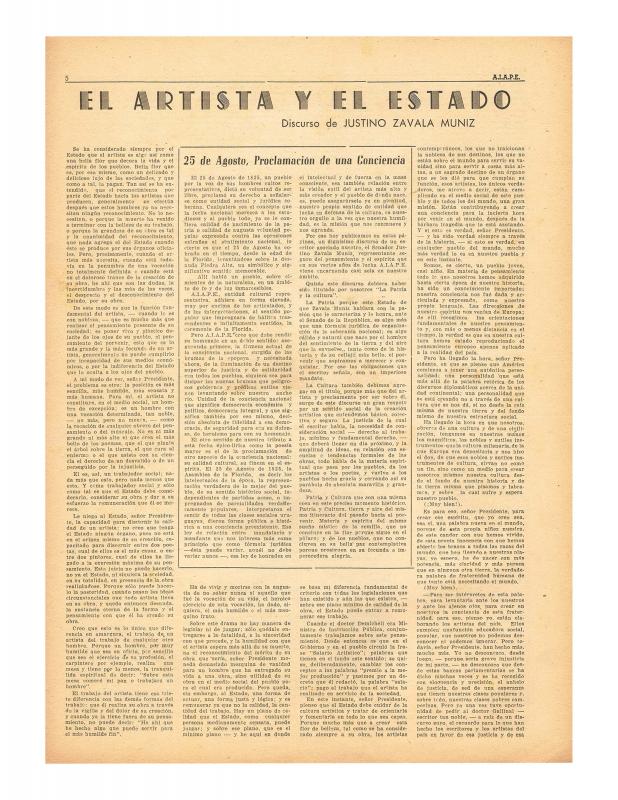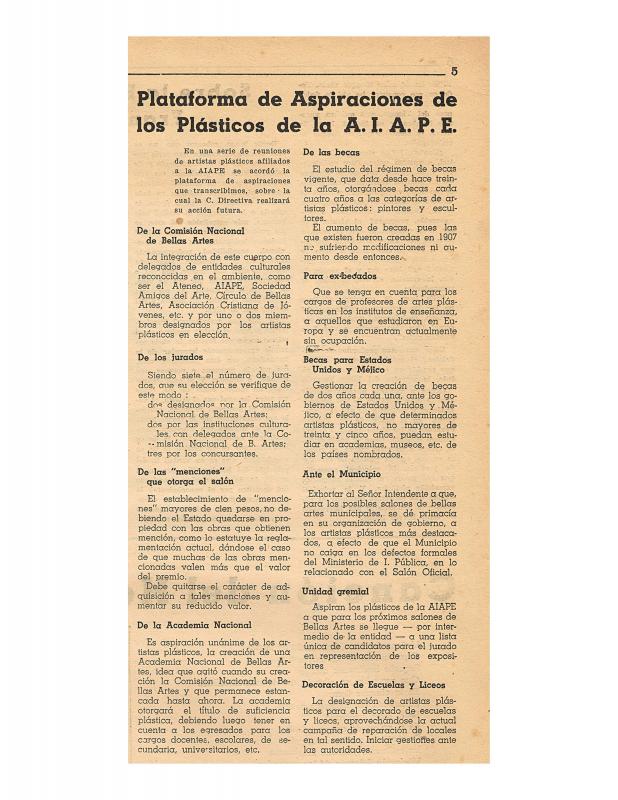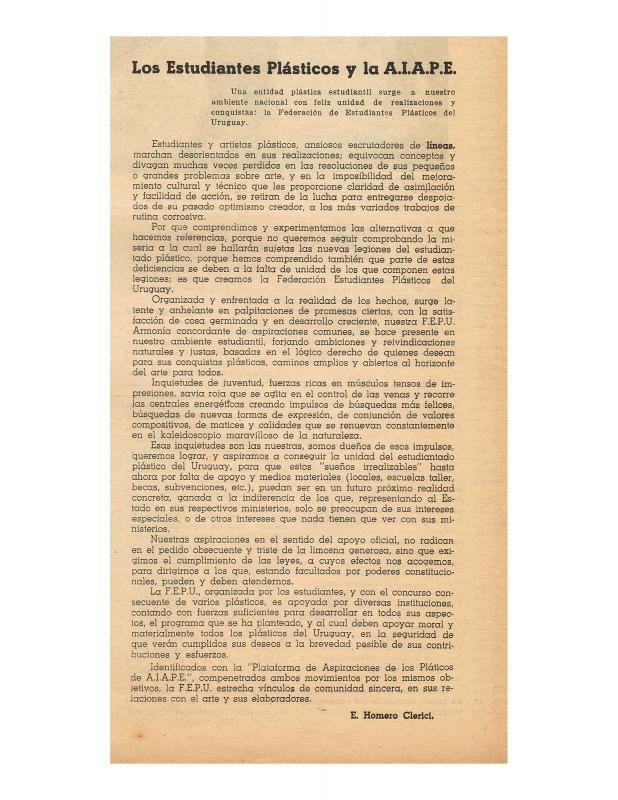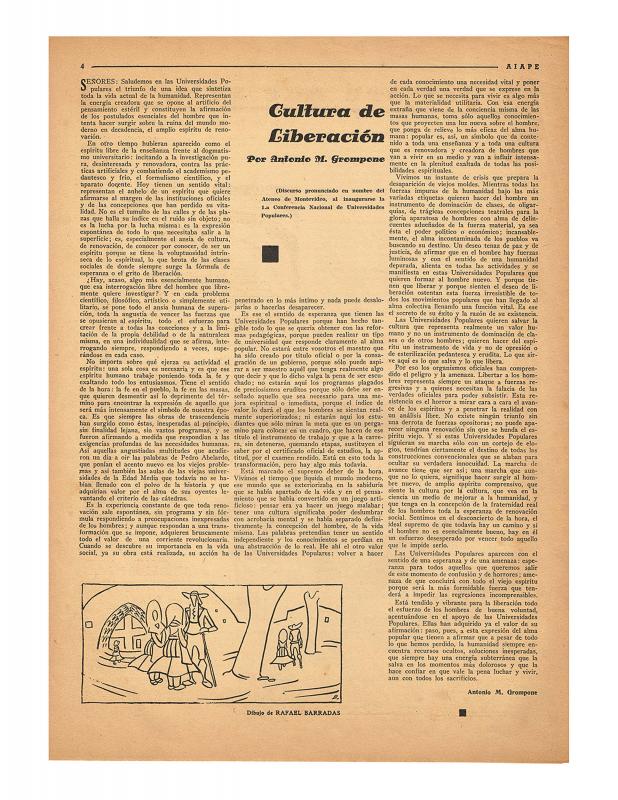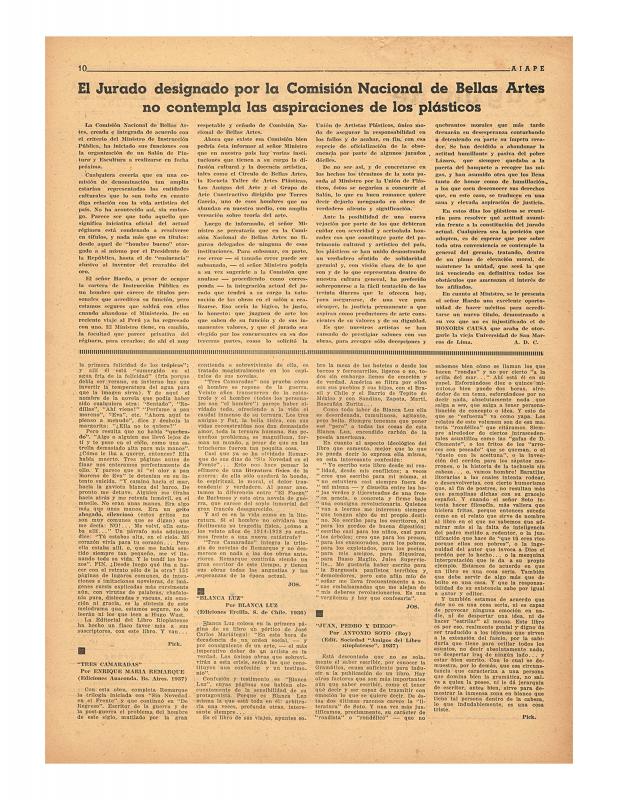The painter Carlos Prevosti, the author of this article, discusses the annual exhibition at which the Uruguayan government remunerated certain artists (selected on their merits by a government jury) as it had ever since this policy of “remunerating artists” began in 1931. Prevosti harshly criticizes the government for choosing jurors who are unfit for the position and for its general lack of interest in the whole process, as demonstrated by the sloppy handling of the exhibition. According to Prevosti, the government was arbitrarily distributing salaries and remuneration that promoted the organization of exhibitions lacking the environment required to dignify artists and their works. He identifies what he calls “chronic deficiencies” at those events, such as grouping sans criteria, deficient lighting, inappropriate venues, a lack of guidance for the public, a disengaged organization that took no interest in bringing exhibitions to all levels of institutions providing art education. Special attention is paid to the lack of authority of designated jurors, and to those who are not required to explain or justify their vote or their decisions. At the time this article was written, the AIAPE (Agrupación de Intelectuales, Artistas, Periodistas y Escritores) was barely a year old; it had, from the very beginning, been relentless in its criticism of the Gabriel Terra dictatorship’s cultural policies. The association was particularly critical of the government’s selection of unfit jurors, who were designated according to the whims of inept ministers, thus overriding the demands that became constant in those years. [As complementary reading see, in the ICAA digital archive, the following articles published in AIAPE: by Joaquín Torres García, “La exposición. [Amigos de España]” (doc. no. 1191197), “El Arte de Arzádum” (doc. no. 1223148), and “El arte de David Alfaro Siqueiros” (doc. no. 1238628); by Cipriano S. Vitureira, “1er Salón Municipal de Artes Plásticas/Su contenido artístico” (doc. no. 1184568), and “La pintura de Miguel Ángel Pareja” (doc. no. 1223795). See also: by Justino Zavala Muniz, “El artista y el Estado” (doc. no. 1216580); “Arte simple,” by Atahualpa del Cioppo (doc. no. 1223119); by Carmelo de Arzadum, “Las artes plásticas de 1936 a 1939” (doc. no. 1224706), and “Urruchúa (doc. no. 1224405); by Roberto Ibáñez (editor in chief), “Demetrio Urruchúa con Nosotros” (doc. no. 1223661), “Los jurados del próximo Salón Nacional de Bellas Artes” (doc. no. 1225548), “Michelena- Escultor” (doc. no. 1223386), and “Plataforma de aspiraciones de los plásticos de la A.I.A.P.E.” (doc. no. 1225398); by Homero Clerici, “Los estudiantes plásticos y la AIAPE [Agrupación de Intelectuales, Artistas, Periodistas, y Escritores]” (doc. no. 1225286); by Felipe Novoa “El grabador Carlos González” (doc. no. 1223870); de Gisleno Aguirre, “La nueva Asociación de Artistas Plásticos” (doc. no. 1225166); by Orestes Baroffio, “Objeto y Significación de Un Salón de Arte” (doc. no. 1210990); and by C.L., “Teseo: los problemas del arte” (doc. no. 1223765). There are also many anonymous articles that were published in AIAPE: “Temas de discusión sobre la cultura Americana” (doc. no. 1225812) “La actividad plástica del año” (doc. no. 1223617); “Alianza de intelectuales, artistas y escritores bolivianos” (doc. no. 1225763); “El arte mejicano” (doc. no. 1225519); “Bases A.I.A.P.E (Agrupación de Intelectuales, Artistas, Periodistas y Escritores)” (doc. no. 1226697); “Cae decorado de Berni bajo la piqueta del G.O.U” (doc. no. 1225213); “Cultura de liberación” (doc. no. 1226424); “Cultura en el orden internacional” (doc. no. 1223996); “La ética social del artista,” unformatted (doc. no. 1223962); “La exposición del Subte a beneficio de Chile,” unformatted (doc. no. 1225245); “Fuera del Salón Oficial” (doc. no. 1221528); “El jurado designado por la Comisión Nacional de Bellas Artes no contempla las aspiraciones de los plásticos” (doc. no. 1225373); “Los jurados de los salarios artísticos de 1935 atentó contra la cultura” (doc. no. 1225596); “La libertad en Portinari” (doc. no. 1225346); “El mensaje de Antonio Berni” (doc. no. 1223596); “Notas editoriales e informativas” (doc. no. 1226398); “Noticia de David Alfaro Siqueiros” (doc. no. 1223640); “Una opinión sobre el 6° Salón Nacional” (doc. no. 1225722); “Optimismo sobre España” (doc. no. 1225185); “Página de crítica y polémica. Las exposiciones” (doc. no. 1221503); “La pintura en el V Salón de Otoño” (doc. no. 1225672); “Reconocimiento a Élie Faure” (doc. no. 1223458); “VIII Salón Nacional de Bellas Artes” (doc. no. 1211227); and “Sobre la querella del realismo” (doc. no. 1225636)].






